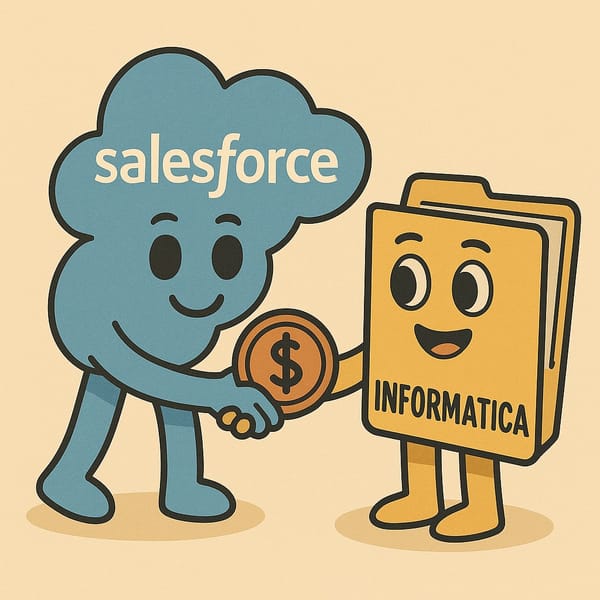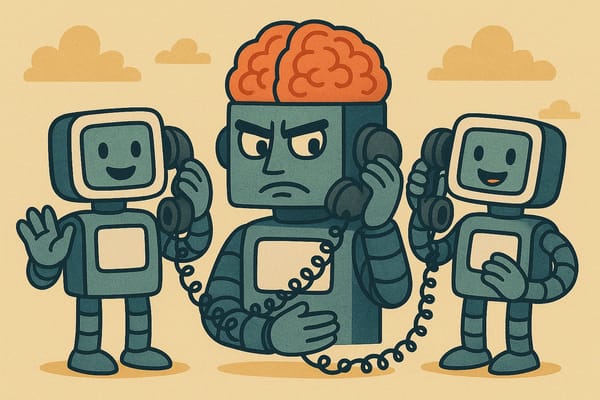The Price is Wrong
Why Hourly Billing in the Era of Industrialized Cognition is Economic Malpractice

We need to talk about pricing in the era of industrialized cognition.
Hourly billing—still clutched by consultants and agencies—has jumped the shark. It's measuring horsepower in hay. Our tools have changed. Our velocity has changed. Pretending otherwise isn't noble; it's negligent.
We are knowledge workers with infrastructure. No longer scribes but distillers commanding intelligent machines. Yet we're expected to bill like we're still hand-carving deliverables in stone.
But here's what they don't want you to understand: this isn't about job displacement. It's about power displacement. The jobs being threatened aren't the ones that create value—they're the ones that extract it. This isn't a replacement. It's a reckoning.
The New Physics of Knowledge Work
Let's zoom in. I personally drop over $850 a month on tooling—GPT-4, Gemini Ultra, Perplexity, Cody, Codeium—plus token usage and custom workflows. That isn't a convenience stack. That's capital investment. I'm not selling my time. I'm operating a factory.
The data backs this up with ruthless precision:
- Harvard-BCG study (758 consultants): GPT-4 users completed 25% more work, 12% faster, with 40% higher quality
- MIT study: Business professionals increased output from 17.7 to 28.3 documents per day—59% improvement
These aren't incremental gains. They're phase changes. And they're terrifying the people whose entire business model depends on inefficiency.
So yes, top-tier consulting should come with a multiplier. If I can deliver 10x the value, 10x faster, then pricing like it's just another hour is malpractice. You don't rent a rocket engine and charge for it like a bicycle.
But more importantly: you don't need their permission anymore. You don't need their capital. You don't need their networks. The means of production just democratized, and the gatekeepers are about to discover what happens when the gates disappear.
The Great Cognitive Dissonance
What's wild is that resistance comes from those best positioned to thrive. The same folks who ship three apps before lunch bill three hours at their old rate. It's not humility—it's a category error. People stuck in pricing schemas that no longer map to reality.
All the imposter syndrome we've been feeling as an industry has been warranted all along. But it's not you. It's the stupid, ineffective machine you're operating in.
Think about the gaslighting at scale: an entire generation of developers convinced they were "bad at estimation" when they were being asked to estimate fiction. Asked to timeline theater. Of course you couldn't estimate how long it takes 25 people to do a one-person job—that's like asking how long it takes 25 people to write a love letter.
The real imposters? They were never the developers who felt like frauds. The real imposters were the layers of management who created no value, the consultants who sold complexity, the gatekeepers who extracted rent from other people's creativity. They were the ones performing expertise while possessing none, selling solutions while creating problems.
At every single point of the deal-making process, people are incentivized to delay and dilute value:
- Sales teams get paid on contract size, not delivery success
- Partners get paid on billable hours, not client outcomes
- Project managers get paid to manage projects that shouldn't exist
Everyone's incentive? Make things bigger, longer, more expensive. Now AI is exposing this entire class of professional parasites, and they're the ones panicking about "disruption." Of course they are. When you've built your career on preventing others from succeeding efficiently, efficiency itself is an existential threat.
Digital Transformation: A Twenty-Year Protection Racket
I work in technology and strategy consulting. The past twenty years have been dominated by "digital transformation"—an endless parade of bloated agile workstreams, overstaffed delivery pods, and cargo cult scrum ceremonies.
But here's what nobody admits: digital transformation never worked because it was never supposed to work.
The entire model was engineered to fail upward. Providers earned more by lowering standards, increasing budgets, and exploding complexity beyond recognition. Here's the formula they don't teach at business school:
- Promise transformation
- Deliver complication
- Bill for remediation
- Repeat until the client is broke or broken
It's an arsonist selling fire insurance—except the fire never goes out because putting it out would end the revenue stream.
The numbers tell the story: 70-95% of digital transformation projects failed. McKinsey's own analysis revealed only 20% of companies achieved more than three-quarters of anticipated revenue gains.
This wasn't tragedy. This was strategy. And now the strategists are terrified—not because AI will replace workers, but because it's revealing that the emperor's entire wardrobe department was a scam.
The Stockholm Syndrome Economy
Here's what's most apt: Stockholm syndrome. We spent a generation gaslighting the entire economy into believing our grift, we forgot we always had the option to just create value and charge for it.
The consulting industry became so invested in its own con that it forgot it was a con. Partners who started their careers knowing it was theater ended their careers believing it was scripture.
We became so sophisticated at explaining why nothing worked that we forgot how to make things work.
Think about how insane this is: an entire industry forgot that you could just... solve problems and charge for solutions. We spent so much energy on the performance of productivity that we forgot what actual productivity looked like.
And now the parasites are panicking. Not because AI threatens jobs—but because it threatens their jobs. The extractors. The rent-seekers. The people who've been living off the delta between what value creators produce and what they're allowed to keep.
The Great Reversal: When Gatekeepers Become Obsolete
Let's be crystal clear about what's happening here. The people with the most to lose in the AI revolution are the ones who've been exploiting the structure of business the whole time. Every unnecessary layer of management, every gatekeeper who controlled access rather than creating value, every intermediary who extracted rent from the flow of work—they're not being replaced. They're being revealed.
The emperor isn't just naked. The emperor was never wearing clothes, and now everyone can see it.
Power structures exist only because of their intrinsic self-validating goal to maintain power. Their leverage came from controlling access—to capital, to decision-makers, to opportunities. But what happens when a developer with $850 worth of AI tools can outperform a $2 million consulting team? What happens when creators can reach audiences without publishers, when builders can ship without bureaucracies, when problem-solvers can deliver solutions without permission?
The leverage is gone. The moat has dried up. The gatekeepers are standing at empty gates.
This isn't a rebellion. It's a revolution. This isn't a riot. It's a reckoning.
For decades, the game was rigged. People with will, insight, and something to care about were trapped in systems designed to ensure their failure. The structural serfdom of trapping bountiful minds into monarchal decree has been laid bare. No matter the merit of your ideas, no matter the elegance of your solutions, success required navigating a labyrinth of artificial obstacles created by people whose only skill was creating obstacles.
Starving artists weren't fools. They were victims of a world where the darkest souls cast shadows over the light others wanted to create, stealing it all and leaving creators in darkness. The "struggling creative" wasn't struggling because their work lacked value—they struggled because the value was systematically extracted by those who positioned themselves between creation and compensation.
Old Model vs. New Model: Same Human, Different Physics
The Old Model
- Seasoned architect leads 25-person team
- Meetings five days a week
- A dozen Jira boards
- Six-figure monthly burn rate
- Everyone exhausted, everything overdue
- No clear product-market fit
Example: Australian Department of Health's Accenture contract ballooning from $18.1 million to $156.9 million—an 8x increase
The New Model
- Same architect, alone with AI tools
- Full-stack copilot, AI analyst, code interpreter
- Vector-indexed knowledge graph
- Shipping product, running experiments
- Automating 90% of previous war room work
McKinsey's "Lilli" validates this at scale—used by 70% of 45,000 employees, saving 30% of time while improving quality.
Same human. Different physics.
The Noise Was the Business Model
Here's the uncomfortable truth: all those backlog grooming sessions, task decomposition, and contributor attrition—most of that was noise. Each handoff, each meeting, each layer of abstraction chips away at clarity.
But noise and lossy compression aren't bugs of the legacy model—they're features. The entire business incentive was to add more people, more tasks, more dollars. Value creation was never the axis. The model was built around value extraction.
Simplicity is a one-time sale. Complexity is an annuity.
Brooks's Law exploitation wasn't a bug—it was the entire business model. Every additional developer made projects later, which justified more developers, which made it even later. A perpetual motion machine of profitable failure.
No. It never was going to take 25 people. Quality issues? Bodycount. Timing issues? Bodycount. "This new team from India is just the same as Brian and Jeff" (but we pay them literally 90% less).
And now? The noise is clearing. The fog is lifting. And what's revealed isn't pretty: an entire class of professionals whose only skill was creating the problems they were paid to solve. The conductors of confusion, the architects of obstruction, the merchants of complexity—they're all standing naked in the harsh light of AI-enabled clarity.
Their protection racket worked as long as they controlled both the problem and the solution. But when one person with AI can bypass the entire circus? Game over.
The Engineers Who Could Ship It By Friday
Just about everyone in my industry has heard it—some burnt-out developer confessing they could get this done by Friday if everyone would just get out of their way.
They meant it. And y'all should have listened.
But listening would have broken the business model. So instead, we buried them under process, drowned them in meetings, and suffocated them with "collaboration." We turned Friday victories into 18-month death marches because it was profitable.
It is not a mistake that software engineers, the smartest people in the room, are constantly held out of decision-making.
You can't run a protection racket if the people who understand the work are in charge of decisions. So we created layers—product managers, project managers, program managers, delivery managers—anything to keep the people who knew how to build away from the people who decided what to build.
The systematic exclusion of technical talent from business decisions wasn't incompetence—it was strategy.
But here's the beautiful irony: those engineers, those "resources," those "individual contributors" we kept in their boxes? They were the revolutionaries all along. Every time they said they could ship it by Friday, they were declaring independence. Every time they built something beautiful despite the system, they were proving the system was unnecessary.
Now they have the tools to prove it at scale. And the empire of empty suits is crumbling.
The Rise of the AI-Powered Solo Symphony
There's this tired handwave—call it the "vibe coding reduction." That AI tools are toys. That they cheapen the craft.
This is the age of orchestration. One skilled operator with finely tuned AI instruments isn't a solo act—they're a damn symphony. The point isn't fewer people. The point is more leverage.
The A.Team survey of 214 elite freelancers proves this:
- 80% believe AI increases their earning potential
- 45% save six or more hours per week
- 68% more likely to pursue independent careers
When lower-performing consultants see 43% productivity improvements with AI, effectively matching top performers, the democratization is complete.
But here's what really matters: this isn't just about efficiency. It's about liberation. Every creator who was trapped in a system that demanded they surrender 90% of their value to access 10% of the resources—they're free now. Every brilliant mind that was told they needed to "pay their dues" in a system designed to extract their best years for someone else's profit—they can simply opt out.
The gatekeepers are screaming about "quality" and "standards" and "process" because they know their protection racket is over. When one person with taste and tools can outperform their entire apparatus, their only response is to claim the game itself is invalid.
Too late. The game has already changed.
The New Pricing Imperative
Simon-Kucher nails the core problem: traditional hourly billing creates a "passthrough problem." If consultants accomplish twice the work in 40 hours but only bill 40 hours, AI becomes a complete passthrough with no benefit.
The solution isn't subtle adjustments. It's fundamental reimagining:
- Value-based pricing captures 5-20% of anticipated client value
- 51% of consultants using value-based pricing achieve $10,000+ project values vs. 39% using hourly
Meanwhile, 66% of buyers will stop working with firms that don't incorporate AI. The market has decided.
The Unleashing
What's being displaced isn't just labor—it's the heavy drag of collaborating with people who don't think like you. The endless back-and-forth. The dead air in meetings. That was the cost of scaling without coherence.
But now? That scaffolding is optional. The support players who needed teams now have one—in the form of model-based leverage. They can build, test, refine, and ship from their own wallet. No permission required.
Millions of roles may dissolve. But millions of minds just got unleashed.
Remember those developers who said they could get it done by Friday? Now they're doing exactly that—shipping in days what took months, building alone what required armies.
This is what happens when the cost of execution collapses. But more importantly, this is what happens when the cost of permission goes to zero. When you don't need to convince a committee to let you try. When you don't need to navigate organizational antibodies designed to preserve the status quo. When you can just... build.
The shackles of capital are gone. The traditional requirement—that you needed someone else's money to turn your ideas into reality—has evaporated. A laptop, a credit card, and the will to create are now sufficient to compete with enterprises that once required millions in funding and armies of employees.
We can try to fight this. And many will. The consulting firms will create "AI ethics committees" and "transformation frameworks" and "governance models"—anything to reinsert themselves into a value chain that no longer needs them. They'll try to convince you that you need their permission, their process, their oversight.
They'll fail. Because once people taste what it's like to create without asking permission, to ship without committees, to solve problems without bureaucracy—there's no going back.
The Attention Economy's New Premium
Because leverage compounds. Ten to the tenth. Two to the tenth. Same exponent, different base—radically different outcome.
When scale is free and distribution is infinite, the constraint is care. That's the new premium. We're not paying for effort. We're paying for taste. For insight. For the ability to spot the interesting move and execute before anyone else sees the board.
And here's what terrifies the old guard: you can't fake caring. You can't systematize taste. You can't offshore giving a damn. The very qualities that make work valuable in the AI age are the ones that can't be extracted, systematized, or stolen. They have to be cultivated, earned, and—most importantly—they have to be real.
BCG's $2.7 billion in AI-related revenue—20% of total revenue, up from zero in two years—shows what happens when firms grasp this shift. But most won't make the transition. They can't. Their entire existence depends on the inefficiencies that AI eliminates.
The Theater Is Over
We can finally dispose of the entire theater around value justification. Just show up and deliver. Sheer abundance, real insight, tight integration, compound leverage. The result isn't just impressive. It's irresistible.
Those burnt-out developers were right all along. They could have gotten it done by Friday. Now, with AI as their force multiplier instead of meetings as their kryptonite, they're proving it daily.
We always had the option to just create value and charge for it. We never needed the theater. We never needed the complexity.
The fact that this sounds radical tells you everything about how deep the Stockholm syndrome went.
Now AI has broken the spell. Not because it's magic, but because it's a mirror. It shows us what one person who actually gives a damn can accomplish when they're not drowning in a sea of people who are paid not to.
It proves what those burnt-out developers always knew: the work was never that hard. The hard part was pretending it was hard enough to justify the circus.
The New Dawn
God is dead. The old hierarchies that claimed divine right to your surplus value have lost their power. I think, therefore I am—and more importantly, I build, therefore I own.
This is bigger than consulting. This is bigger than software. This is about every field where layers of extraction have been inserted between those who create and those who benefit. Every industry where "that's just how things work" has been used to justify why creators starve while middlemen feast.
To everyone who actually gives a damn, who's been grinding away in the shadows cast by those who only take: your time has come. To every developer who knew it could be simple, every designer who watched their vision get compromised to death, every creator who was told their work had no value by people who produced nothing:
Congratulations. Let's make something really fucking cool and keep what we earn doing it.
The ones who embrace that will print money.
The rest? They're already obsolete. They just don't know it yet.




